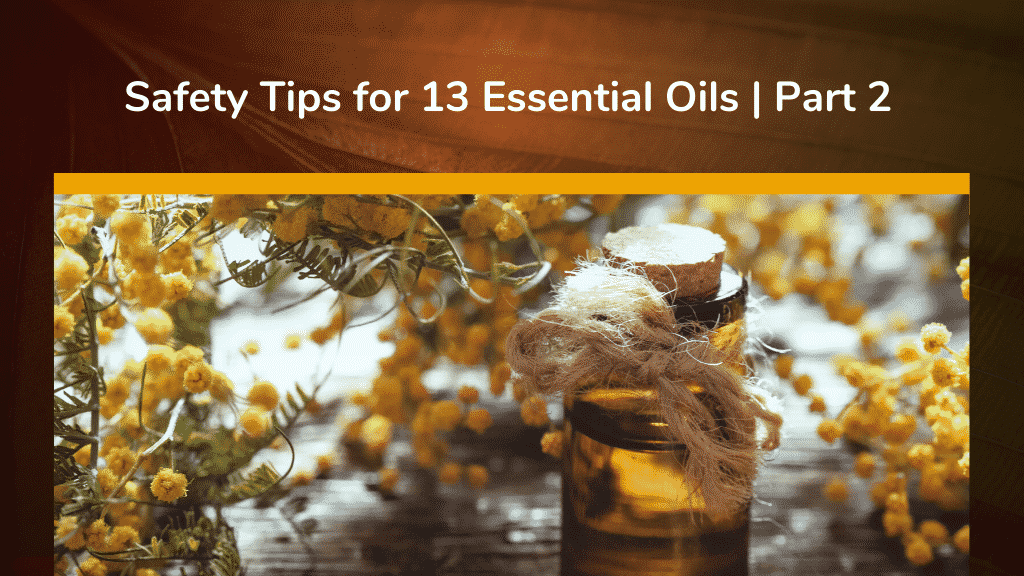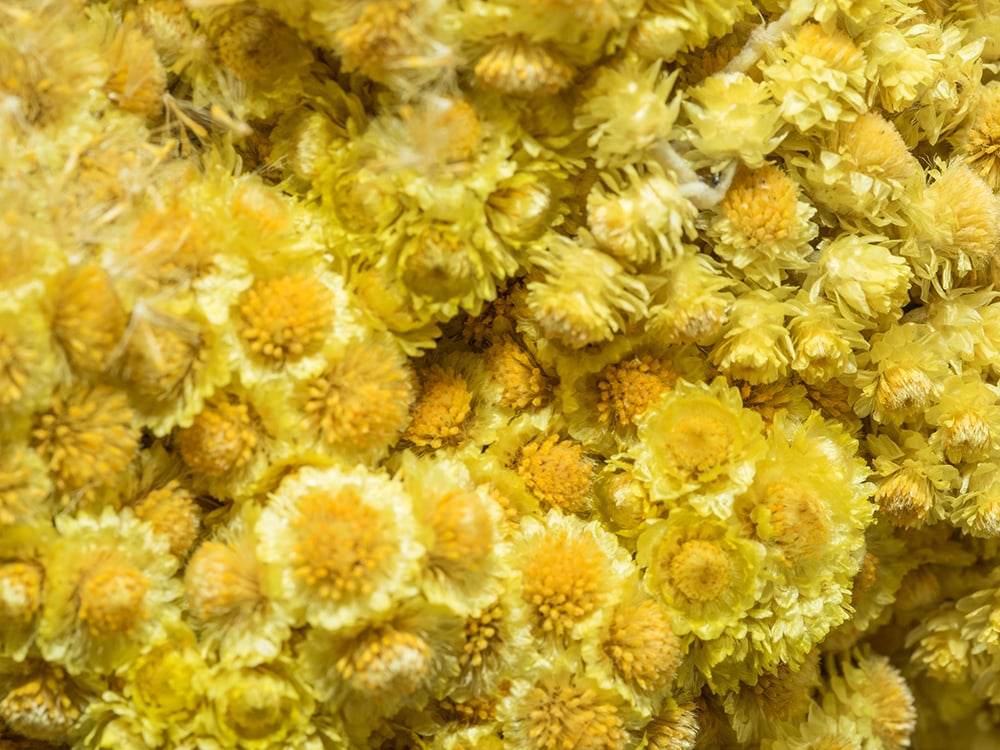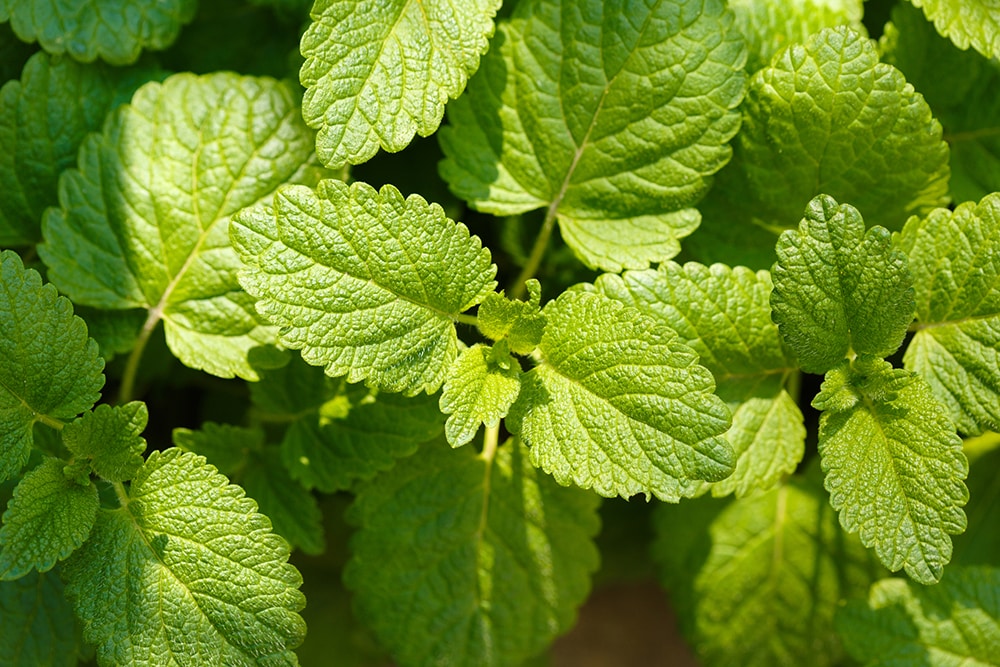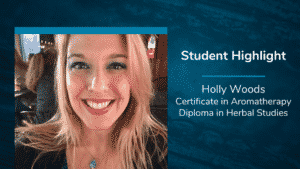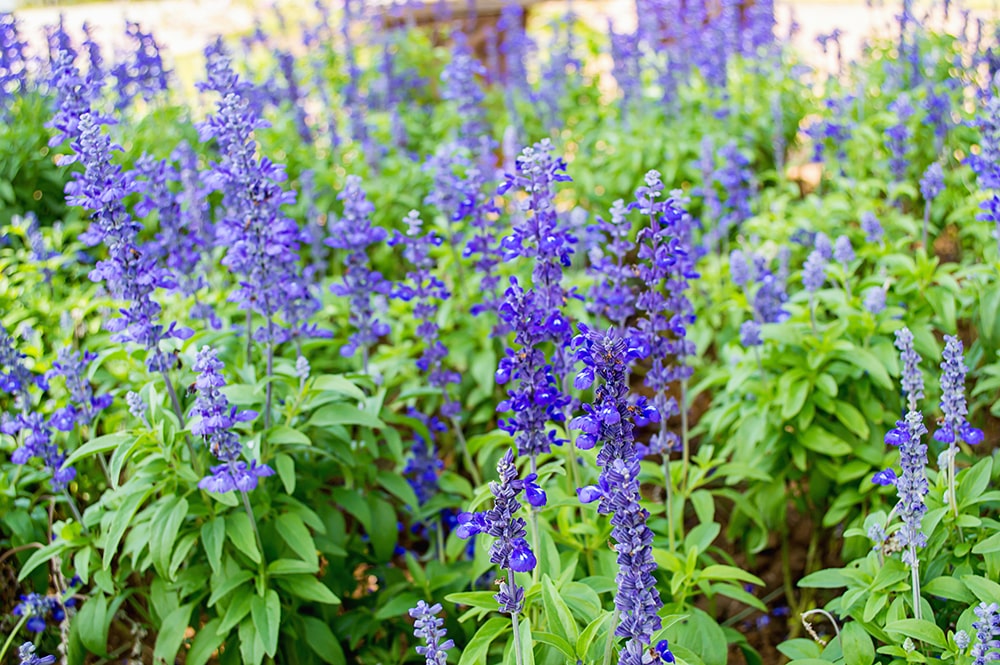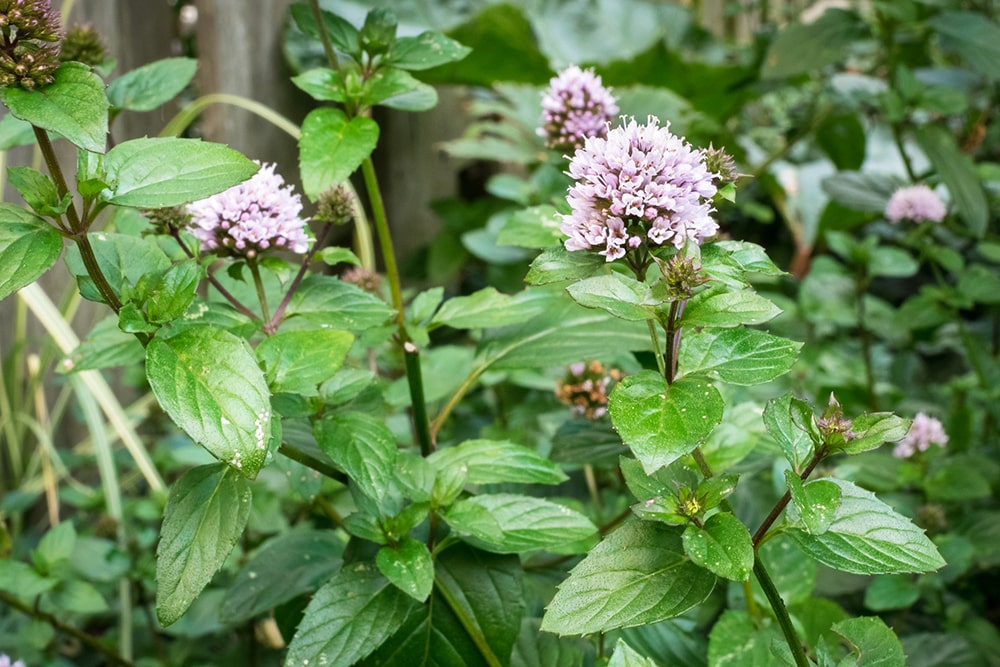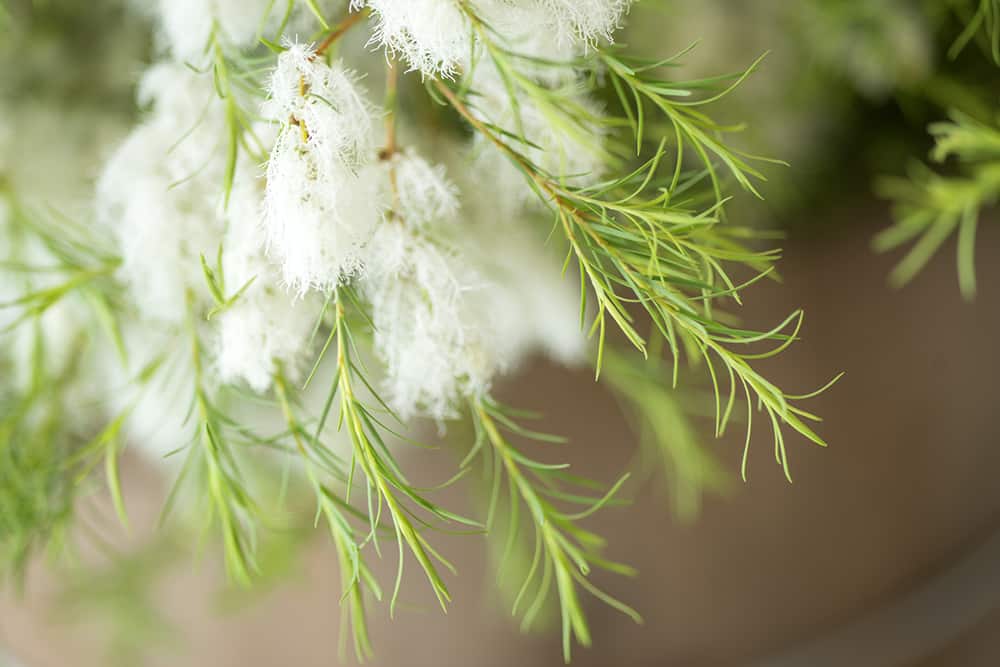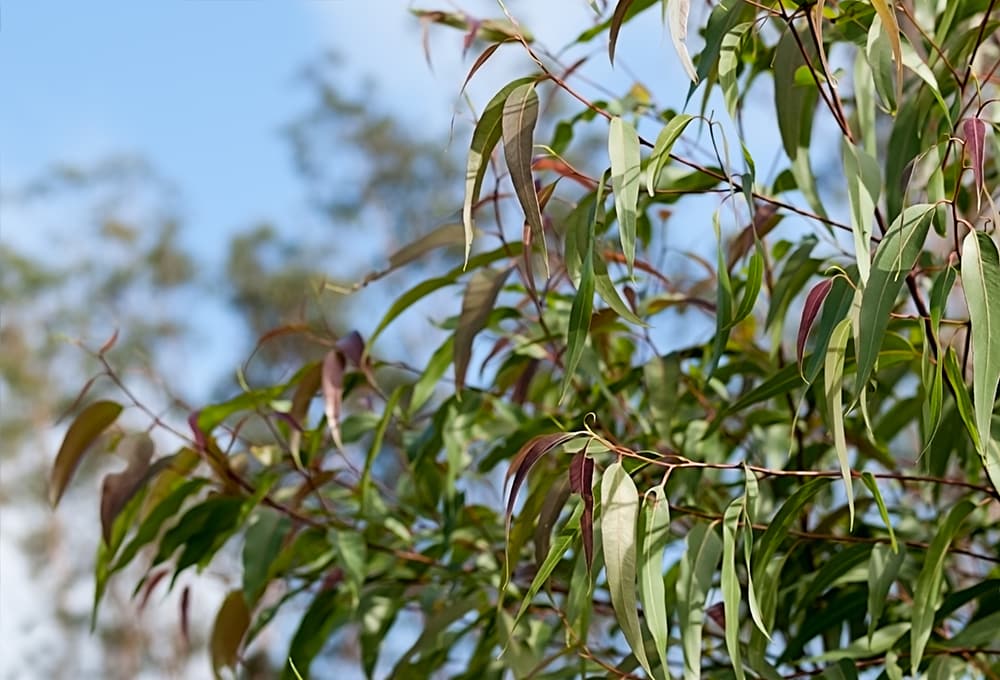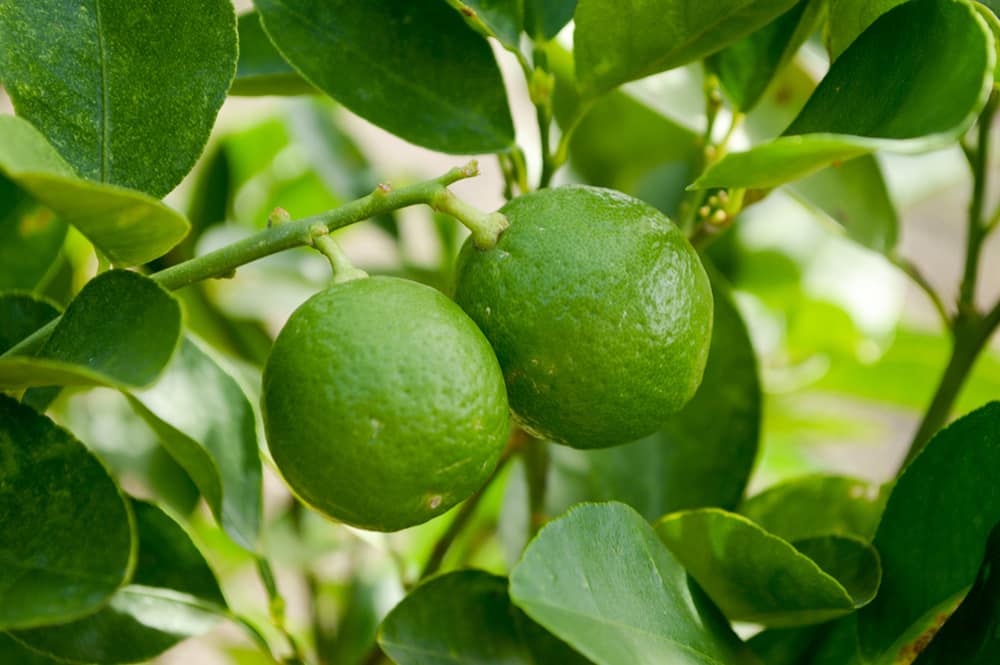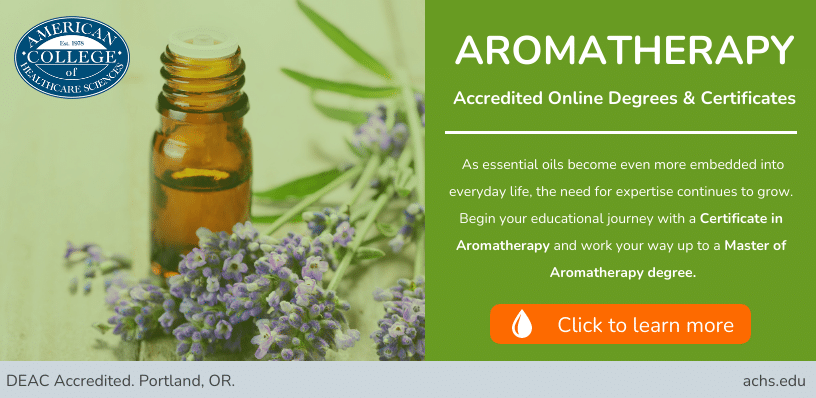By ACHS Founding President Dorene Petersen, BA, Dip.NT, Dip.Acu, RH (AHG)
In this blog post, ACHS Founding President Dorene Petersen shares her expertise with valuable safety tips for seven essential oils. You can read part 1 with six more essential oil profiles here, and we hope you find part 2 equally informative.
7. Essential Oil of Helichrysum
Latin Name: Helichrysum angustifolium (Pers.), H. italicum (Roth), H. stoechas, H. gymnocephalum, or H. arenarium. This species is influenced by the location or region where it is grown which creates different chemotype profiles. Each variety will contain a unique constituent profile.
Family: Asteraceae (formerly Compositae)
Recommended Daily Use
Topical application:
Adults: Dilute 3 drops in 2 teaspoons (10ml) of carrier oil or another safe diluent. Use this diluted preparation over a 24 hour period in 3 to 4 topical applications, or use the complete amount for one full bath.
Dilution ratio 1%.
Please note: These dilution ratios are based on the conversion of 30 drops of essential oil = 1ml.
Inhalation:
Adults: Inhaled via a diffuser. Note: When diffusing, don’t exceed 30 minute intervals and diffuse in well-ventilated areas.
If any adverse reactions occur, discontinue use and consult with a physician.
Cautions and Contraindications
Steam distilled immortelle essential oil is not reported to cause skin irritation, sensitization, or phototoxicity[1]. The absolute may be a very mild skin irritant.
Toxic Rating
The American College of Healthcare Sciences toxic rating is I and a skin patch test is recommended if skin is hypersensitive or if you are allergic to plants in the Asteraceae family.[2]
Regulatory Status
Immortelle essential oil is listed on the FDA Generally Recognized as Safe (GRAS) list[3] and the absolute is listed on the FDA Substances Added to Food list formerly the Everything Added to Food in the U. S. (EAFUS). [4]
8. Essential Oil of Melissa
Latin Name: Melissa officinalis (L.)
Family: Lamiaceae (formerly Labiatae)
Recommended Daily Use
Topical application:
Adults: Dilute 1 drops in 1 teaspoon (5ml) of carrier oil or another safe diluent. Use this diluted preparation over a 24 hour period in 3 to 4 topical applications, or use the complete amount for one full bath.
Dilution ratio 0.9%.
Please note: These dilution ratios are based on the conversion of 30 drops of essential oil = 1ml.
Inhalation:
Adults: Inhaled via a diffuser. Note: When diffusing, don’t exceed 30 minute intervals and diffuse in well-ventilated areas.
If any adverse reactions occur, discontinue use and consult with a physician.
Cautions and Contraindications
Melissa essential oil contains the aldehyde citral which is potentially toxic. It is important to follow the daily use guidelines. Citral can inhibit the activities of P450 cytochrome pathway drug metabolizing enzyme (CYP2B6) which increases the plasma level of certain medications.[5] Caution should be applied if using melissa essential oil at the same time as these drug categories: Anesthetics, Antiarrhythmics, Anticoagulants, Anticonvulsants, Antidepressants, Antidiabetics, Antiepileptics, Anti-inflammatories, Antimalarials, Antiretrovirals, Chemotherapeutics, Monoamine Oxidase Inhibitors (MAOI), Opioids, Psychotropics, and Steroids.[6] Avoid during pregnancy, and do not use if skin is hypersensitive, diseased or damaged or for children under 2 years of age.
Citral, which consists of geranial and neral, becomes even more skin sensitizing if oxidized. [7] Correct storage is important.
Toxic Rating
The American College of Healthcare Sciences toxic rating is III.[8]
Regulatory Status
Melissa essential oil is listed on the FDA Generally Recognized as Safe (GRAS) list[9] and the essential oil is also listed on the FDA Substances Added to Food list formerly the Everything Added to Food in the U. S. (EAFUS).[10]
9. Essential Oil of Clary Sage
Latin Name: Salvia sclarea (L.)
Family: Lamiaceae
Recommended Daily Use
Topical application:
Adults: Dilute 1 drop in 1 tablespoon (15 ml) of carrier oil or another safe diluent. Use this diluted preparation over a 24 hour period in 3 to 4 topical applications, or use the complete amount for one full bath.
Dilution ratio 0.25%.
Please note: These dilution ratios are based on the conversion of 30 drops of essential oil = 1ml.
Inhalation:
Adults: Inhaled via a diffuser. Note: When diffusing, don’t exceed 30 minute intervals and diffuse in well-ventilated areas.
If any adverse reactions occur, discontinue use and consult with a physician.
Cautions and Contraindications
Historically, clary sage S. sclarea essential oil was thought to have a hypotensive (blood pressure lowering) effect. This is supported by a 2013 study showing a significant decrease in both diastolic and systolic blood pressure. [11] Another study on rats showed hypotensive actions.[12]
Clary sage S. sclarea contains sclareol which some authors suggest has estrogenic activity. There is no evidence supporting this activity but be aware, sclareol content varies considerably and can be higher if the oil is obtained via solvent or CO2 extraction.[13] Because of this use clary sage S. sclarea oil with caution during pregnancy only after the first trimester.
Also, some aromatherapy publications have stated that clary sage is effective for epilepsy, others state it should never be used. Epilepsy is a serious condition that should only be treated by a qualified healthcare practitioner. While there is no evidence that clary sage should be contradicted in the case of epilepsy, there have been reports of thujone being present in clary sage if it is distilled when it is setting seed.[14] [15] Always check the constituent profile in which case it should be avoided as thujone is a central nervous system stimulant and neurotoxin.
Toxic Rating
The American College of Healthcare Sciences toxic rating is II.[16]
Regulatory Status
Clary sage essential oil is listed on the FDA Generally Recognized as Safe (GRAS) list [17] and is on the Substances Added to Food list.[18]
10. Essential Oil of Peppermint
Latin Name: Mentha ×piperita (L.)
Family: Lamiaceae
Recommended Daily Use
Topical application:
Adults: Dilute 3 drops in 2 teaspoons (10 ml) of carrier oil or another safe diluent. Use this diluted preparation over a 24 hour period in 3 to 4 topical applications, or use the complete amount for one full bath.
Dilution ratio 1%.
Please note: These dilution ratios are based on the conversion of 30 drops of essential oil = 1ml.
Inhalation:
Adults: Inhaled via a diffuser. Note: When diffusing, don’t exceed 30 minute intervals and diffuse in well-ventilated areas.
If any adverse reactions occur, discontinue use and consult with a physician
Cautions and Contraindications
Peppermint essential oil may cause contact dermatitis so a skin patch test is recommended.[19] . Do not use it directly on damaged or sensitive skin without a skin patch test. Do not use peppermint with children younger than two years as it can cause a frightening cold then hot sensation if the dilution is not low enough. In amounts higher than the recommended daily use, peppermint M. ×piperita oil has been known to cause allergic reactions in the mouth, neck, and throat.
Anyone with a glucose-6-phosphate dehydrogenase (G6PD) deficiency should avoid peppermint oil via any administrative route as it may impact red blood cell activity. Glucose-6-phosphate dehydrogenase (G6PD) deficiency is a condition in which red blood cells break down when the body is exposed to certain drugs or the stress of infection. It is hereditary, so is passed down in families.[20] [21]
Anyone with gastroesophageal reflux disease (GERD) should avoid peppermint essential oil orally (and potentially topically), as it may aggravate the condition.[22]
Topically for adults, use peppermint for a limited time only (i.e., no more than three consecutive weeks) and keep at a 1% dilution.
Do not get it in your eyes. If you wipe your eye by mistake after handling peppermint M. ×piperita, flush copiously with cold water or milk. It will not cause permanent damage.
Toxic Rating
The American College of Healthcare Sciences toxic rating is II.[23]
Regulatory Status
Peppermint essential oil is on the FDA substances that are Generally Recognized as Safe (GRAS) list [24] and Substances Added to Food list.[25]
Additional EOS for EO Safety Microcredential Classes
11. Essential Oil of Tea Tree Australia
Latin Name: Melaleuca alternifolia (Cheel.) (syn Melaleuca linariifolia var. alternifolia (Maid. & Bet.))
Family: Myrtaceae
Recommended Daily Use
Topical application:
Adults: Dilute 6 drops in 2 teaspoons (10ml) of carrier oil or another safe diluent. Use this diluted preparation over a 24-hour period in 3 to 4 topical applications, or use the complete amount for one full bath.
Dilution ratio 2%.
Note: These dilution ratios are based on the conversion of 30 drops of essential oil = 1ml.
Oxidized alpha-terpinene within tree essential oil may cause allergic skin reactions[1]. A skin patch test is recommended if tea tree is to be used on a regular basis or if there is a history of allergic skin reactions. Correct and careful storage is critical.
Inhalation:
Adults: Inhaled via a diffuser. Note: When diffusing, don’t exceed 30-minute intervals and diffuse in well-ventilated areas.
If any adverse reactions occur, discontinue use and consult with a physician.
Cautions & Contraindications
Tea tree Australia does not have FDA Generally Recognized as Safe (GRAS) status in the United States[2]. However, it is not on the Everything Added to Food in the United States (EAFUS) list[3].
If the oil has high 1,8 cineole content, it may in rare cases cause skin irritation. Use a skin patch test if you have sensitive skin. Tisserand states from 1991–2000 there were 29 cases of an allergic reaction to tea tree oil. However, note that in 21 of them the undiluted oil was used[4]. This is a good reminder to always check the contraindications and cautions for each oil and of how necessary it is to dilute oils before applying topically.
Also, you may have seen tea tree contraindicated because of its estrogenic potential. Apparently, it does show weak estrogenic activity in vitro when mice are the test subjects and the constituents are tested in isolation. However, when essential oil is used in its entirety as whole oil there are other synergistic factors that affect the outcome. Be cautious when you read in vitro animal research conducted with individual constituents. Tisserand also states that none of the potentially estrogenic constituents (such as terpinen-4-ol, alpha-terpineol, and 1,8 cineole) penetrate human skin[5]. However, this does not consider those constituents entering the blood stream through inhalation. Because the evidence is somewhat inconclusive the author recommends proceeding with caution if using tea tree oil therapeutically with, for example, an estrogen-dependent breast cancer.
Safety Precaution
Note: With essential oils containing 1,8 cineole over 10% avoid prolonged (longer than 15 minutes in a well-ventilated room) inhalation for children under ten years of age. The essential oil should not be applied full strength to the face, eyes, or nose. It should not be applied to the face or nose of infants or children under 10 years of age. Duration of exposure is as important as concentration. This is an important safety consideration throughout your studies; always consider dose and duration whenever you use essential oils.
Oxidized alpha-terpinene within tree essential oil may cause allergic skin reactions. Once oxidized by air, absorbed, it is transformed metabolically, and activated to form sensitizing compounds. A skin patch test is recommended if tea tree is to be used on a regular basis or if there is a history of allergic skin reactions. Correct and careful storage is critical.
ACHS Toxic Rating
The American College of Healthcare Sciences toxic rating is II.
12. Essential Oil of Lemon Eucalyptus
Latin Name: Eucalyptus citriodora (Hook.) (syn Corymbia citriodora (Hook.) is considered a subspecies)
Family: Myrtaceae
Recommended Daily Use
Topical application:
Adults: Dilute 6 drops in 2 teaspoons (10ml) of carrier oil or another safe diluent. Use this diluted preparation over a 24-hour period in 3 to 4 topical applications, or use the complete amount for one full bath.
Dilution ratio 2%.
Note: These dilution ratios are based on the conversion of 30 drops of essential oil = 1ml.
Inhalation:
Adults: Inhaled via a diffuser. Note: When diffusing, don’t exceed 30-minute intervals and diffuse in well-ventilated areas.
If any adverse reactions occur, discontinue use and consult with a physician.
Cautions & Contraindications
Lemon eucalyptus E. citriodora essential oil does not have Generally Recognized as Safe status (GRAS) for use in foods in the U.S.
Tisserand says when used undiluted on rabbit paws it was irritating, but when it was tested at a 10% dilution on 25 volunteers, it was neither irritating nor sensitizing[1]. It does not cause photosensitivity. As a precaution when used topically, dilute to at least a 2% dilution.
ACHS Toxic Rating
The American College of Healthcare Sciences toxic rating is II.
[1] Tisserand, R. & Young, R. (2014). Essential oil safety: A guide for health care professionals. (2nd ed.). Churchill Livingstone Elsevier, 336.
13. Essential Oil of Lime
Latin Name: Citrus aurantifolia (Christm.) Swingle
Family: Rutaceae
Recommended Daily Use
Topical application:
Adults: Dilute 2 drops in 2 teaspoons (10ml) of carrier oil or another safe diluent. Use this diluted preparation over a 24-hour period in 3 to 4 topical applications, or use the complete amount for one full bath.
Dilution ratio of expressed lime is .7% to avoid photosensitivity.
Distilled lime essential oil can be used at higher dilution rates without causing photosensitivity.
Expressed lime contains furocoumarin. Restrictions for furocoumarin containing essential oils have been recommended by IFRA[1]. While we do not study all furocoumarin containing oils in detail that are listed below. However, they are listed here to ensure you know these essential oils contain furocoumarins:
- Angelica root oil – Angelica archangelica (L.)
- Bergamot oil expressed – Citrus aurantium (L.) var. bergamia
- Bitter orange oil expressed – Citrus aurantium (L.) var. amara
- Cumin oil – Cuminum cyminum (L.)
- Grapefruit oil expressed – Citrus paradisi (Macfad.)
- Lemon oil cold pressed – Citrus limonum (Risso)
- Lime oil expressed – Citrus aurantiifolia (Christm.)
- Rue oil – Ruta graveolens (L.)
Also, where the oils are used in combination with other phototoxic essential oils, the additive effect has to be taken into consideration and the use levels have to be reduced accordingly. The list below is essential oils that are phototoxic.
- Mandarin oil cold pressed – Citrus reticulata (Blanco)
- Petitgrain mandarin oil – Citrus aurantium (L.)
- Tangerine oil cold pressed – Citrus tangerina (L.)
- Parsley leaf oil – Petroselinum crispum (Mill.)
Note: These dilution ratios are based on the conversion of 30 drops of essential oil = 1ml.
Inhalation:
Adults: Inhaled via a diffuser. Note: When diffusing, don’t exceed 30-minute intervals and diffuse in well-ventilated areas.
If any adverse reactions occur, discontinue use and consult with a physician.
Cautions & Contraindications
Lime has Generally Recognized as Safe (GRAS)[2] status in the U.S. when it is used orally in amounts commonly found in food, and it is on the Substances Added to Food list[3].
Topically, lime C. aurantifolia oil may cause hypersensitivity[4].
Note: Coumarins, linalool, and linalol are potential photosensitizers. Use with caution.
Distilled lime oil is non-irritating, non-sensitizing, and non-phototoxic to human skin, but expressed lime C. aurantifolia oil and lime peel can cause phototoxic skin reactions[5]. Avoid exposure for 12 hours after using lime oil topically. It should be diluted to 0.7% in a final topical product[6].
ACHS Toxic Rating
The American College of Healthcare Sciences toxic rating is II.
Disclaimer: This article is for informational purposes only. It is not intended to treat, diagnose, cure, or prevent disease. This article has not been reviewed by the FDA. Always consult with your primary care physician or naturopathic doctor before making any significant changes to your health and wellness routine.
References
[1] D.L.J. Opdyke: Monographs on fragrance raw materials. Food Cosmet. Toxicol. 17(Suppl), 1979.
[2] Toxic Rating: I = Low, II = Moderate, III = High (Low Therapeutic Margin)
[3] U.S. Food & Drug Administration. (2019, April 1). CFR – code of federal regulations 21. Retrieved from https://www.accessdata.fda.gov/scripts/cdrh/cfdocs/cfcfr/CFRSearch.cfm?fr=182.20
Electronic Code of Federal Regulations. (2020, January 23). Title 21 food and drugs. Retrieved from https://www.ecfr.gov/cgi-bin/text-idx?SID=3ee286332416f26a91d9e6d786a604ab&mc=true&tpl=/ecfrbrowse/Title21/21tab_02.tpl
[4]U.S. Food & Drug Administration. (2020, January 14). Immortelle, absolute (Helichrysum Angustifolium DC). Retrieved from https://www.accessdata.fda.gov/scripts/fdcc/index.cfm?set=FoodSubstances&id=IMMORTELLEABSOLUTEHELICHRYSUMANGUSTIFOLIUMDC&sort=Sortterm&order=ASC&startrow=1&type=basic&search=immortelle
[5] Seo, K. A., Kim, H., Ku, H. Y., Ahn, H. J., Park, S. J., Bae, S. K.,…Liu, K.H. (2008).The monoterpenoids citral and geraniol are moderate inhibitors of CYP2B6 hydroxylase activity. Chemical-Biological Interactions, 174(3), 141-146. doi:10.1016/j.cbi.2008.06.003
[6] Horn John R.,Hansten, PharmD Philip D., Get to Know an Enzyme: CYP1A2 retrieved from https://www.pharmacytimes.com/publications/issue/2007/2007-11/2007-11-8279 January 2020
[7] Hagvall L, Bråred Christensson J. Cross-reactivity between citral and geraniol - can it be attributed to oxidized geraniol?. Contact Dermatitis. 2014;71(5):280–288. doi:10.1111/cod.12293
[8] Toxic Rating: I = Low, II = Moderate, III = High (Low Therapeutic Margin)
[9] Electronic Code of Federal Regulation. (2020, January 23). Subpart A: General provisions. Retrieved from https://www.ecfr.gov/cgi-bin/retrieveECFR?gp=&SID=3d8c169c5de41bf23cc4dda73d62e879&mc=true&n=sp21.3.182.a&r=SUBPART&ty=HTML#se21.3.182_120
[10] U.S. Food & Drug Administration. (2020, January 14). Substances added to food (formerly EAFUS)Retrieved from https://www.accessdata.fda.gov/scripts/fdcc/?set=FoodSubstances&sort=Sortterm&order=ASC&startrow=1&type=basic&search=Melissa%20officinalis%20
[11] Seol, G.H., Lee, Y.H., Kang,P., You, J.H., Park, M., & Min, S.S. (2013). Randomized Controlled Trial for Salvia sclarea or Lavandula angustifolia: Differential Effects on Blood Pressure in Female Patients with Urinary Incontinence Undergoing Urodynamic Examination. Journal of Alternative and Complementary Medicine, 19(7):664-670.
[12] Campos DR, Celotto AC, Albuquerque AAS, et al. The Diterpene Sclareol Vascular Effect in Normotensive and Hypertensive Rats [published online ahead of print, 2017 Jun 29]. Arq Bras Cardiol. 2017;109(2):0. doi:10.5935/abc.20170086
[13] Farkas, P., Holla, M., Tekel, J., Mellen, S., & Vaverkova, S. (2005). Composition of the Essential Oils from the Flowers and Leaves of Salvia sclarea L. (Lamiaceae) Cultivated in Slovak Republic. J. Essential Oil Res., 17:141-144.
[14] Sharopov, F. & Setzer, W. (2012). The Essential Oil of Salvia sclera L. from Tajikistan. Rec. Nat. Prod., 6(1):75-79.
[15] Saharkhiz, M., Ghani, A., & Hassanzadeh-Khayyat, M. (2009). Changes in Essential Oil Content and Composition of Clary Sage (Salvia sclera) Aerial Parts During Different Phenological Stages. Medicinal and Aromatic Plant Science and Biotechnology, 3(1):90-93.
[16] Toxic Rating: I = Low, II = Moderate, III = High (Low Therapeutic Margin)
Electronic Code of Federal Regulation. (2020, January 23). Subpart A: General provisions. Retrieved from https://www.ecfr.gov/cgi-bin/retrieveECFR?gp=&SID=3d8c169c5de41bf23cc4dda73d62e879&mc=true&n=sp21.3.182.a&r=SUBPART&ty=HTML#se21.3.182_120
U.S. Food & Drug Administration. (2020, January 14). Substances added to food (formerly EAFUS). Retrieved from https://www.accessdata.fda.gov/scripts/fdcc/?set=FoodSubstances&sort=Sortterm&order=ASC&startrow=1&type=basic&search=Melissa%20officinalis%20
[19] Wilkinson SM, Beck MH. Allergic contact dermatitis from menthol in peppermint. Contact Dermatitis. 1994;30(1):42–43. doi:10.1111/j.1600-0536.1994.tb00728.x
[20] U.S. National Library of Medicine. (2020, January 6). Glucose-6-phosphate dehydrogenase deficiency. Retrieved from https://medlineplus.gov/ency/article/000528.htm
[21] Olowe SA, Ransome-Kuti O. The risk of jaundice in glucose-6-phosphate dehydrogenase deficient babies exposed to menthol. Acta Paediatr Scand. 1980;69(3):341–345. doi:10.1111/j.1651-2227.1980.tb07090.x
[22] Jarosz, M., & Taraszewska, A. (2014). Risk factors for gastroesophageal reflux disease: the role of diet. Przeglad gastroenterologiczny, 9(5), 297–301. doi:10.5114/pg.2014.46166
[23] Toxic Rating: I = Low, II = Moderate, III = High (Low Therapeutic Margin)
Electronic Code of Federal Regulation. (2020, January 23). Subpart A: General provisions. Retrieved from https://www.ecfr.gov/cgi-bin/retrieveECFR?gp=&SID=3d8c169c5de41bf23cc4dda73d62e879&mc=true&n=sp21.3.182.a&r=SUBPART&ty=HTML#se21.3.182_120
U.S. Food & Drug Administration. (2020, January 14). Substances added to food (formerly EAFUS). Retrieved from https://www.accessdata.fda.gov/scripts/fdcc/?set=FoodSubstances&sort=Sortterm&order=ASC&startrow=1&type=basic&search=Melissa%20officinalis%20
[26] European Commission. (n.d.). Scientific committee on consumer safety SCCS: Opinion on fragrance allergens in cosmetic products [PDF]. https://ec.europa.eu/health/scientific_committees/consumer_safety/docs/sccs_o_102.pdf
[27] http://www.accessdata.fda.gov/scripts/cdrh/cfdocs/cfcfr/CFRSearch.cfm?fr=182.20 accessed 9/3/13
[28] http://www.accessdata.fda.gov/scripts/fcn/fcnNavigation.cfm?filter=melaleuca&sortColumn=&rpt=eafusListing
[29] Tisserand, R. & Young, R. (2014). Essential oil safety: A guide for health care professionals. (2nd ed.). Churchill Livingstone Elsevier: 28.
[30] Tisserand, R. & Young, R. (2014). Essential oil safety: A guide for health care professionals. (2nd ed.). Churchill Livingstone Elsevier: 444.
[31] Tisserand, R. & Young, R. (2014). Essential oil safety: A guide for health care professionals. (2nd ed.). Churchill Livingstone Elsevier, 336.
[32] International Fragrance Society. (2015, June 10). IFRA standards. [Booklet]. https://ifrafragrance.org/docs/default-source/ifra-code-of-practice-and-standards/ifra-standards—48th-amendment/ifra-standards-in-full—booklet.pdf
[33] §182.20 Essential oils, oleoresins (solvent-free), and natural extractives (including distillates).
https://www.accessdata.fda.gov/scripts/cdrh/cfdocs/cfCFR/CFRSearch.cfm?fr=182.20
SUBSTANCES GENERALLY RECOGNIZED AS SAFE https://www.accessdata.fda.gov/scripts/cdrh/cfdocs/cfCFR/CFRSearch.cfm?fr=182.20
[34] Substances Added to Food (formerly EAFUS)
[35] Roesyanto-Mahadi, I.D., Geursen-Reitsmas, A.M., van Joost, T., et al. (1990). Sensitization to fragrance materials in Indonesian cosmetics. Contact Dermatitis, 22:212-217.
[36] Leung, A.Y. & Foster, F. (1996). Encyclopedia of Common Natural Ingredients Used in Food, Drugs and Cosmetics. New York, NY: John Wiley & Sons.
[37] Tisserand, R. & Young, R. (2014). Essential oil safety: A guide for health care professionals. (2nd ed.). Churchill Livingstone Elsevier, 338.
About American College of Healthcare Sciences

This commitment to our students and graduates reflects in our current survey results that reflect 98% of our students would recommend ACHS to a friend or family member.
We believe education is the most powerful tool for changing an individual and the world around us.
When a person enrolls as ACHS, it is vitally important that they graduate with tools they need to forge their own holistic and sustainable missions, build up their communities confidently and changing the face of healthcare with knowledge.
- President’s Message: End Of Year Reflectionsby American College of Healthcare Sciences●December 31, 2020
- Student Highlight: Wife and Husband Team Start New Businessby American College of Healthcare Sciences●December 22, 2020
- Student Highlight: Holistic Health, Gratitude, and Smoothies |achs.eduby American College of Healthcare Sciences●December 17, 2020
- 3 Tips For Building Better Habitsby American College of Healthcare Sciences●December 10, 2020
